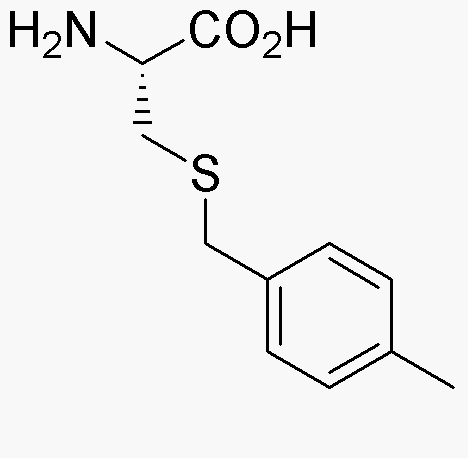S-4-Methylbenzyl-L-cysteine is widely utilized in research focused on:
- Pharmaceutical Development: This compound is explored for its potential in drug formulation, particularly in creating targeted therapies for conditions like cancer, due to its unique sulfur-containing structure that may enhance bioactivity.
- Antioxidant Research: It is studied for its antioxidant properties, which can help in developing supplements or functional foods aimed at reducing oxidative stress in the body.
- Biochemical Studies: Researchers use it to investigate protein interactions and enzyme activities, providing insights into metabolic pathways and cellular functions.
- Cosmetic Applications: The compound is being evaluated for its skin-protective effects, making it a candidate for inclusion in skincare products aimed at combating aging and environmental damage.
- Food Industry: Its potential as a flavor enhancer or preservative is being researched, which could lead to innovative food products with improved shelf life and taste.
General Information
Properties
Safety and Regulations
Applications
S-4-Methylbenzyl-L-cysteine is widely utilized in research focused on:
- Pharmaceutical Development: This compound is explored for its potential in drug formulation, particularly in creating targeted therapies for conditions like cancer, due to its unique sulfur-containing structure that may enhance bioactivity.
- Antioxidant Research: It is studied for its antioxidant properties, which can help in developing supplements or functional foods aimed at reducing oxidative stress in the body.
- Biochemical Studies: Researchers use it to investigate protein interactions and enzyme activities, providing insights into metabolic pathways and cellular functions.
- Cosmetic Applications: The compound is being evaluated for its skin-protective effects, making it a candidate for inclusion in skincare products aimed at combating aging and environmental damage.
- Food Industry: Its potential as a flavor enhancer or preservative is being researched, which could lead to innovative food products with improved shelf life and taste.
Documents
Safety Data Sheets (SDS)
The SDS provides comprehensive safety information on handling, storage, and disposal of the product.
Product Specification (PS)
The PS provides a comprehensive breakdown of the product’s properties, including chemical composition, physical state, purity, and storage requirements. It also details acceptable quality ranges and the product's intended applications.
Certificates of Analysis (COA)
Search for Certificates of Analysis (COA) by entering the products Lot Number. Lot and Batch Numbers can be found on a product’s label following the words ‘Lot’ or ‘Batch’.
*Catalog Number
*Lot Number
Certificates Of Origin (COO)
This COO confirms the country where the product was manufactured, and also details the materials and components used in it and whether it is derived from natural, synthetic, or other specific sources. This certificate may be required for customs, trade, and regulatory compliance.
*Catalog Number
*Lot Number
Safety Data Sheets (SDS)
The SDS provides comprehensive safety information on handling, storage, and disposal of the product.
DownloadProduct Specification (PS)
The PS provides a comprehensive breakdown of the product’s properties, including chemical composition, physical state, purity, and storage requirements. It also details acceptable quality ranges and the product's intended applications.
DownloadCertificates of Analysis (COA)
Search for Certificates of Analysis (COA) by entering the products Lot Number. Lot and Batch Numbers can be found on a product’s label following the words ‘Lot’ or ‘Batch’.
*Catalog Number
*Lot Number
Certificates Of Origin (COO)
This COO confirms the country where the product was manufactured, and also details the materials and components used in it and whether it is derived from natural, synthetic, or other specific sources. This certificate may be required for customs, trade, and regulatory compliance.


